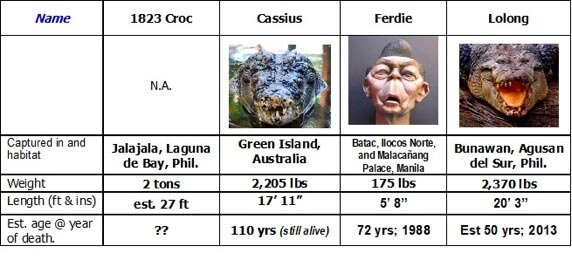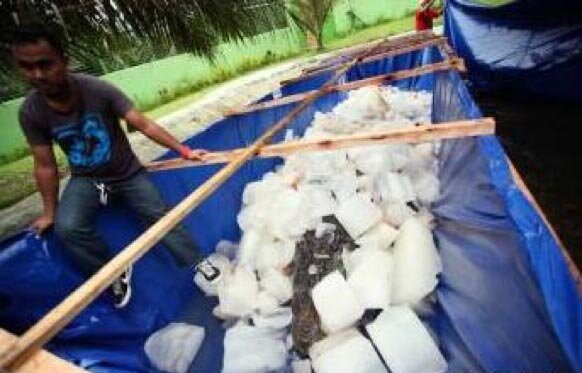Lolong, The Giant Crocodile’s Legacy is a Wake-Up Call
/The conus Gloria-maris seashell which, like a seductive woman, exudes one of the deadliest saltwater shell poisons when its inhabitant is disturbed and extends its toxic intruder organ in defense.
The Pilandok (or Philippine Mouse Deer (tragalus nigircans) is considered the world’s smallest hoofed animal.
The world’s Largest Saltwater Pearl, the Palawan 2016 Princesa (see https://www.positivelyfilipino.com/magazine/pearls-of-the-orient-seas?rq=largest%20pearl PositivelyFilipino article June 27, 2018)
The Giant Golden-crowned Flying fox (Acerdon jubatus), reputedly the largest bat in the world.
In 2010, a strange, icky organism called the “giant shipworm,” resembling a police baton, was discovered and shared in scientific circles. It was given the scientific name of kuphus polythalamia. The creature isn’t even a worm or “nematode” but a bivalve (similar to mussels, clams, etc.,) and is the main staple in a delicacy called “tamilok.” It was discovered near the Sultan Kudarat Bay in Mindanao but will not be available any time soon at your local Jollibee.
A nightstick? A baton? Hold your other thoughts . . .
https://www.facebook.com/everythingexplainedshow/videos/538292163172811/
Another product of Mindanao, the multi-titled Manny Pacquaio, is an octuple—no, not an eight-armed creature, although that’s how he might seem to his opponents, but one who has won eight different titles, medals in eight different categories of his specific field, boxing. The very successful champ also sidelines as a senator of the land.
A unique, extravagant insect, the Iron Butterfly, imeldux fetishus marcosis, of the collecting kind. The lone specimen was known not to have taken its shoe-collecting hobby seriously, thus fell from grace. One must attend this rare butterfly’s birthday celebrations with great caution. More than 200 individuals were food-poisoned at her last birthday fete when the Butterfly, convicted again recently in a court of law, should have been spending that milestone caged, behind bars.
But we have the title of having been the home to the largest saltwater crocodile (crocodylus porosus) in captivity as of 2011. The croc (buwaya) in question was “Lolong.”
Lolong, a magnificent beast—a prime example of his species.
Lolong was one unique reptile from Agusan del Sur in Mindanao, who basked in the spotlight for about a year and a half under rather restrained circumstances. From 2011-2013 he held a world title—the Largest Saltwater Crocodile in Captivity at the time—and that title was certified by the Guinness Book of World Records. Weighing in at 2,370 pounds, Lolong was king of his kind (we’ll call him a “he” to at least render the critter a little respect).
Lolong was captured in his habitat, the Agusan Marsh, a protected wildlife sanctuary in the Agusan Basin in eastern Mindanao, comprising nearly 15 million hectares or some 57.2 sq. miles. The area covers several municipalities including Bunawan, which led the charge for his capture; the area where the hoard of Surigao gold was found is not too far away (see https://www.positivelyfilipino.com/magazine/the-story-behind-the-philippine-gold?rq=philippine%20gold Positively Filipino, September 2016). There are many mines, large and small, surrounding the protected area. When finally captured in 2011, Lolong was so immense that it took 60 men to subdue and harness him before he was transported to his new home.
It took a village to overcome one gigantic crocodile. Poor Lolong, trussed up, rendered helpless and deprived of his innate dignity in his capture on September 2011. Note how huge that torso is compared to its later, preserved version.
The creature was named after prominent Palawan crocodile hunter Ernesto “Lolong” Coñate. “Lolong” is a derivative of “lolo” the Filipino term for grandfather (in turn, derived from the Spanish abuelo). Coñate had led the search for the notorious man-eating crocodile but suffered a fatal heart attack a few days before the croc was captured in September 2011. Hence, the captured croc was named in his honor. Eventually, it was Coñate’s assistant who led the successful effort.
The morning after Lolong was captured (a screengrab from the National Geographic film).
How Old was Lolong?
Dr. Britton estimated Lolong to have been roughly 50 (human) years old, which would have placed him at being born in the early 1960s, at about the same time one Ferdinand Marcos came to national power. For sure, Lolong was a fully grown adult male by the time of his capture in 2011, but there really isn’t a sufficient body of knowledge to tell how old these wild creatures live; as such “50” made a nice round estimate.
Good Times Came to Bunawan
When the Guinness Book confirmed Lolong’s title, the town of Bunawan then staked its claim to its unique captive, and the townspeople looked forward to a mini-tourist industry of sorts. The villagers quickly built Lolong his own little eco-park-pen, and visitors from far and wide did come and pay admission fees to see the champion specimen. The town’s enterprising bakers even created the palatable and whimsical “Lolong loaf.”
Pan de Lolong
Doubts Lingered
As the National Geographic documentary details, there were fears that Lolong wasn’t really the predator that the locals wanted him to be. Even after his capture, Lolong’s chief captor held his doubts that this was the giant man-eater. Some witnesses had claimed that Lolong was not the culprit they had encountered earlier but rather there was another, even more gigantic beast still out there.
To dispel those initial doubts, the villagers subjected Lolong to a purgative session. He was pumped with clean fresh water until he upchucked all the contents of his belly. The session, however, failed to yield any hair, bones, horns or hooves of unlucky prey. In retrospect, the procedure, a severe form of “water-boarding,” would be considered torture for any other creature were Lolong not a pre-condemned as “vicious predator.”
So there followed calls to release Lolong. Even PETA-Philippines (People for the Ethical Treatment of Animals) weighed in. It strongly urged the villagers to let him go back to his wild habitat since they did not find any proof that this was their man-eating menace.
Of course, the Bunawanese refused. They took umbrage that this meddling, moralistic outside entity was poking its nose into business that wasn’t theirs. Besides, the village had captured its own mascot at great risk.
Did the Bunawan villagers have the true culprit in their clutches or were they merely lucky in having captured a huge but unlucky crocodile? Lolong, it seems was meted a sentence of captivity for his only “crime”—being himself, a crocodile, granted a ruthless predator, as nature intended him to be.
Another Giant Philippine Crocodile
Lolong was not the first gigantic captive crocodile captive nor will he be the last. Historically, there is a record of an apparently even bigger Philippine crocodile. Supposedly in 1823 another giant saltwater croc was killed in Luzon near the peninsular town of Jalajala, Rizal, by Laguna de Bay. That specimen reportedly measured 27 feet long and upon dissection, the remains of a horse in seven pieces was found. The Jalajala monster’s existence was recorded by both the local Spanish friars, certified by the nearby secular authorities, and one Paul P. de la Gironiere, a Frenchman who settled in the vicinity of Jalajala, in his memoirs 20 Ans aux Philippines (“Twenty Years in the Philippines,” translated from the original French to its first English edition, ca 1853).
But for now, a comparative study of the world’s other, largest known, most documented crocodiles in history:
What Killed Lolong?
The good times didn’t last long for Lolong. On February 10, 2013, he gave up the ghost. The necropsy revealed that the champion crocodile expired from a variety of causes: multiple organ failure; muscular atrophy; stress; and eventually, pneumonia. All of this was unintentionally caused by is confinement in a very small pen with a concrete bottom without the water depth he needed to feel safe. His captors, who did not know much better, devised a schedule and system of admission wherein fees were based on how much you could see of Lolong. A shallow water level that revealed nearly all of Lolong was the most expensive viewing price and gave the paying visitors their money’s worth. In the nearly 1.5 years of captivity, Lolong raised more than two millions pesos in admission fees.
When Lolong passed in February 2013, a necropsy—the skinning of the carcass and other post-mortem procedures—was performed in order to study and preserve the astounding specimen that Lolong was.
Awaiting a dissection of his hide and skeletal system, Lolong was placed “on the rocks” (on ice)… speaking of “cold-blooded creatures,”
Lolong’s bones being dried in the sun. (I hope they were numbered sequentially.) These were first buried in Lolong’s Eco-Park in Bunawan and would form his skeletal exhibit there. Casts were made for the taxidermy job by the National Museum in Manila.
“Why grandpa (Lolong), what big teeth you have!.” Poor Lolong’s snout on ice in 2013, before being shipped off to better storage in Davao. The head did not survive the post-mortem preservation stages.
Even in death, Lolong somehow proved to be “self-sufficient.” The two million pesos earned from his gig as a “carnival” exhibit helped pay for the immediate taxidermy needed in preserving his carcass before the bureaucracy in Manila could designate funds for his final disposition.
Until that formal agreement was brokered, Lolong’s carcass was kept in freezers at Davao City’s Crocodile Park for a few months, where, unfortunately, there wasn’t a cooler long enough to contain his whole carcass. Hence, his head had to be cut off. A Memorandum of Agreement (MoA) between the still a-forming, new National Museum of Natural History in Manila and the Bunawan town authorities was signed in July 2013. By the MoA, the National Museum would inherit and enshrine Lolong in its then-planned new Museum (at that time, scheduled to open in 2017).
Lolong Now “Resides” in Manila
Earlier this year, I had the opportunity to visit the new Museum of Natural History in Manila where Lolong sort of gets “star” billing. The museum is a state-of-the-art, high-tech institution and is something Filipinos should be very proud of. Above all, it is free admission, so there is no excuse not to go familiarize oneself with the country’s unique flora and fauna.
What’s left of Lolong – now at the National Museum of Natural History of the Philippines. Notice how much smaller the preserved carcass is. The head/snout is synthetic and was very difficult to recreate. The docent informed me that Lolong might have shrunk as much as 15% in the taxidermal stages; so it is so much shorter by at least three (3) feet and also, a smaller girth accordingly. (Photo author’s collection.)
Polluted Environment from Mining
Strangely enough, the issue of where Lolong’s organs would go was overlooked in the MoA. So while his hide and skeleton were transported to Manila, the organs stayed behind in Bunawan. When the necropsy was completed, scientists were shocked to learn of the very high levels of mercury in Lolong’s organs, especially the liver. Lolong supposedly lived in a very pristine setting, the Agusan marshes, but that setting apparently no longer was. The run-off from small gold mining operations in the area, had polluted the Agusan watershed.
When the National Museum scientists tried to raise an alarm, they were instructed by the Department of Environment and Natural Resources (DENR) to keep it quiet. This happened at roughly the same time that the renewal of the late Gina Lopez as Secretary of the Department of Environment and Natural Resources (DENR) was being blocked in the Philippine Senate. Coincidence? Hardly. After all, funding for such things as a National Museum, could easily be curtailed by more powerful mining interests. Thus, same old, same old scenario in the Philippines (as in the US as well).
Lolong’s Legacy
Of course, the humble, primitive beast had unintentionally left a legacy in contemporary Filipino literature and political satire. At the height of Lolong-mania in 2011-13, and because hard, cold national funds were involved with so mundane a matter as the preservation of a mere creature’s remains, the politically savvy could not help but come up with jibes and all-too-obvious comparisons between the celebrated predator and its human counterparts in the political scene. Herewith, a brief sampling of the merry lore engendered by Lolong.
Exhibit A – A Resolution (wink-wink) by the Congress of the Philippines
Republic of the Philippines
Philippine Congress
Joint Resolution No. 9765
Filed on February 11, 2013
RESOLUTION
EXPRESSING THE PROFOUND GRIEF AND SORROW OF PHILIPPINE CONGRESS ON THE DEATH OF CROCODILE LOLONG
WHEREAS, Crocodile Lolong peacefully joined his creator yesterday, February 10, 2013 at 8:05PM of undetermined cause in Bunawan, Agusan Del Sur;
WHEREAS, Lolong shot to prominence after Guinness World Records representatives and international crocodile experts confirmed it to be the world’s largest in captivity;
WHEREAS, Lolong touched the lives not only of Bunawan residents but of Filipinos here and around the globe for setting a world record;
WHEREAS, Lolong and his family are an ‘inspiration’ to many of us here in Congress and the government;
WHEREAS, Lolong ‘represents’ many, if not all of us here in Congress, thus he will be missed, and will always be remembered.
NOW, THEREFORE, BE IT RESOLVED BY PHILIPPINE CONGRESS to express its profound grief and sorrow on the demise of one of our own… Crocodile Lolong.
RESOLVED, FURTHER, that a copy of this resolution be furnished to the Bunawan (Agusan Del Sur) Municipal Council.
Adopted.
Source: https://professionalheckler.com/2013/02/11/so-long-lolong/ LOL!!
Exhibit B – In Literature
Only in the Philippines.
So Long, Lolong, King of the Buwayas (“crocodiles”)
Perhaps the story of Lolong will inspire others to treat captive animals, even if only for scientific and scholarly purposes, more humanely and properly. “Lolong” can be seen today at the new National Museum of Natural History of the Philippines on Teodoro Valencia Circle in Manila.
The author on his February 2019 visit to the new Museum of Natural History of the Philippines, with what’s left of Lolong.. (Photo author’s collection.)
His skeleton hangs separately in another hall. (Photo author’s collection.)
Perhaps, Lolong’s greatest legacy should be a warning. No matter how glorious and state-of-the-art the new National Museum is, the moral compass of the country’s leading scientific and cultural institutions still seems to be under the sway of “special interests” who put profit over everything else.
Lolong presented contemporary Filipinos with two moral questions they should ask themselves:
(1) Was PETA right after all? What gives man the right and moral superiority to take a creature from the wild, hold it captive in an improper, synthetic environment, especially when it was circumstantially proven that he had eaten no humans at all? Lolong was, after all, one of God’s and nature’s magnificent creatures yearning to breathe and live free, unbound and unshackled—just like you and me.
(2) His incarceration killed him, but should the wake-up to stop further pollution of the environment, go ignored? Should today’s more enlightened generation not heed Lolong’s clarion cry for help for the environment and address the matter headlong? No time and no excuse to pussyfoot around “special interests.” Lolong, the primordial predator, is telling the contemporary Filipino something. Listen up, mga kababayan (countrymen), wake up and act before it’s too late.
SOURCES:
https://filipiknow.net/lolong-philippines-largest-crocodile/
http://newsinfo.inquirer.net/56141/%E2%80%98lolong%E2%80%99-the-crocodile-hunter
http://www.guinnessworldrecords.com/world-records/largest-crocodile-in-captivity
https://www.youtube.com/watch?v=Umnnisn21uQ
Myles A. Garcia is a Correspondent and regular contributor to www.positivelyfilipino.com. His newest book, “Of Adobe, Apple Pie, and Schnitzel With Noodles – An Anthology of Essays on the Filipino-American Experience and Some. . .”, features the best and brightest of the articles Myles has written thus far for this publication. The book is presently available on amazon.com (Australia, USA, Canada, Europe, and the UK).
Myles’ two other books are: Secrets of the Olympic Ceremonies (latest edition, 2016); and Thirty Years Later. . . Catching Up with the Marcos-Era Crimes published last year, also available from amazon.com.
Myles is also a member of the International Society of Olympic Historians (ISOH) for whose Journal he has had two articles published; a third one on the story of the Rio 2016 cauldrons, will appear in this month’s issue -- not available on amazon.
Finally, Myles has also completed his first full-length stage play, “23 Renoirs, 12 Picassos, . . . one Domenica”, which was given its first successful fully Staged Reading by the Playwright Center of San Francisco. The play is now available for professional production, and hopefully, a world premiere on the SF Bay Area stages.
For any enquiries on the above: contact razor323@gmail.com
More articles from Myles A. Garcia





















